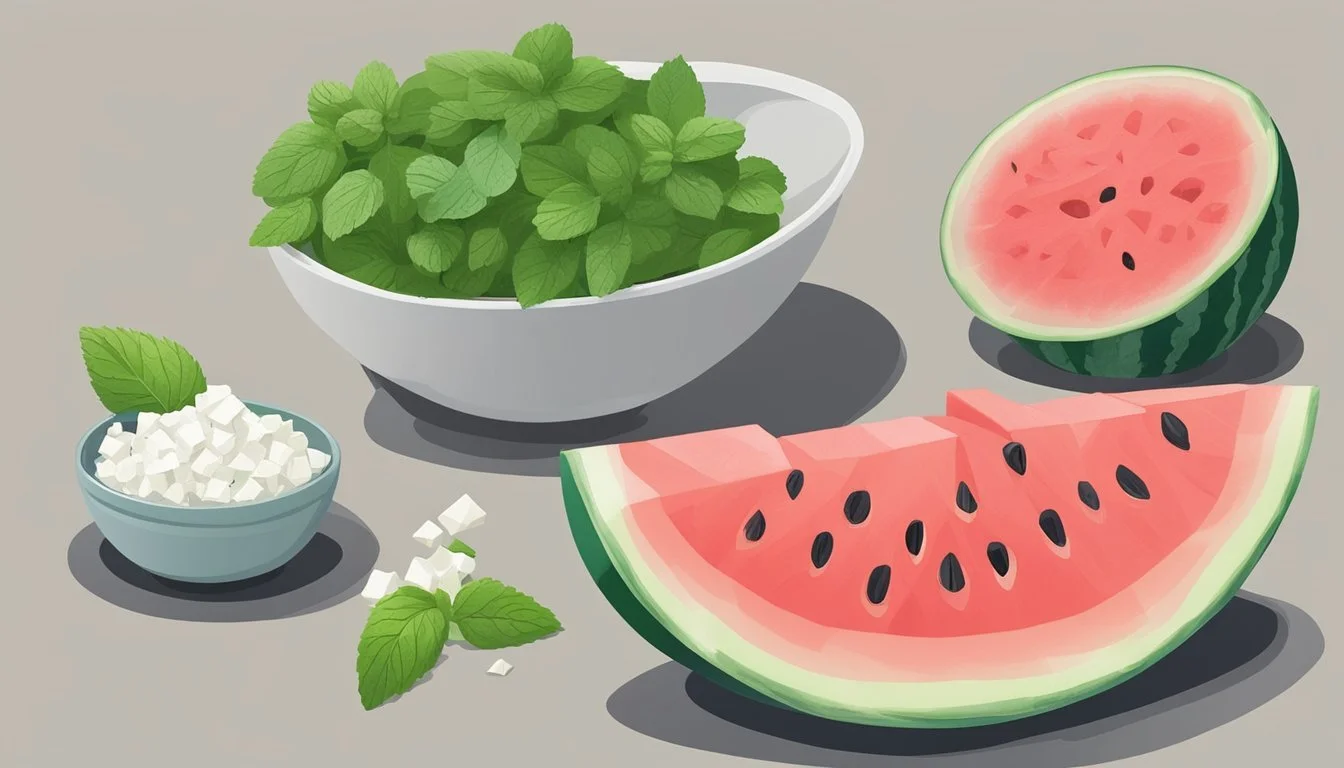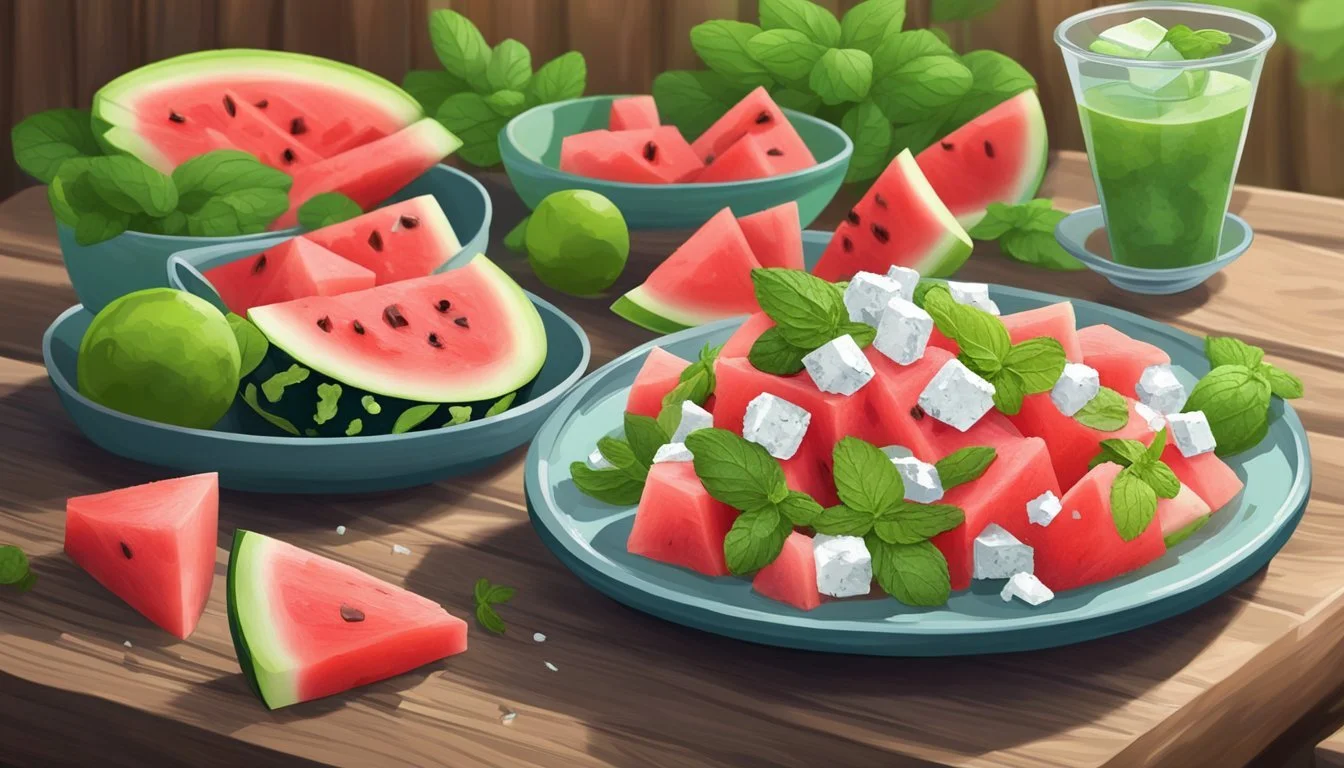How to Make a Refreshing Texas Watermelon Salad
Your Perfect Summer Dish
As the summer sun shines, a refreshing Texas watermelon salad becomes the quintessential healthy snack. Packed with juicy watermelon, this dish epitomizes the essence of summer cuisine—light, fresh, and incredibly easy to prepare. The natural sweetness of the watermelon offers a vibrant base for a variety of complementary textures and flavors, making it a crowd-pleasing option for any gathering or a simple family meal.
The key to crafting a superb watermelon salad lies in the balance of ingredients. The crispness of fresh cucumber, the tang of a suitable acid like lime juice, and the creaminess of cheese (how long does cheese last?)such as feta, meld together with the watermelon's sweetness to create a dynamic eating experience. A handful of fresh herbs (how long do fresh herbs last?), such as mint or cilantro (how long does cilantro last?), provides a burst of flavor that lifts the salad, transcending it from a mere side dish to the star of the dining table.
Adding a Texas twist, one might incorporate local ingredients such as spicy peppers or a dash of local honey, adjusting the flavor profile to suit personal preference while honoring the regional palate. In doing so, the salad remains not just a testament to the versatility of the watermelon, but also a celebration of local Texas fare. Whether enjoyed poolside, at a picnic, or on a quiet porch, this refreshing watermelon salad is a delightful way to savor the flavors of summer.
Selecting Quality Ingredients
When creating a Texas Watermelon Salad, one must choose ingredients with care and consideration to ensure the best flavor and freshness.
Choosing the Right Watermelon
For an ideal Texas Watermelon Salad, an individual should select a ripe, seedless watermelon. He or she can check for ripeness by examining the watermelon for a creamy yellow spot, indicating where it rested on the ground and ripened in the sun. The fruit should feel heavy for its size, a sign of ample, juicy flesh. A gentle thump should produce a hollow sound, signaling that the inside is ripe and ready. Remember, the exterior should be firm and free of bruises.
Selecting Fresh Herbs
To infuse the salad with vibrant flavor, chefs should incorporate fresh herbs like mint and basil (how long does basil last?). The leaves of these herbs should be bright, clean, and free from dark spots. Fresh mint is a staple in watermelon salads (What wine goes well with salads?) for its cooling effect, whereas fresh basil can offer a sweet, peppery element. One can find the freshest herbs at local farmers' markets or grow them at home for the most aromatic experience in their dishes.
Preparing the Ingredients
Selecting fresh and ripe ingredients is crucial for a vibrant and flavorful Texas Watermelon Salad. Proper preparation ensures that each element retains its texture and complements the overall dish.
Cutting and Dicing
For a uniform salad, it's important to have consistent shapes and sizes. Begin with a ripe watermelon; it should be heavy for its size with a creamy yellow spot where it rested on the ground. Cut the watermelon on a cutting board into bite-sized cubes and transfer them to a bowl using a slotted spoon to avoid excess liquid. Next, the cucumber should be sliced into half-moon shapes and the onion into thin slices. If adding tomatoes, they should be seeded and diced to match the watermelon cubes.
Watermelon: Cut into bite-sized cubes.
Cucumber: Slice into half-moons.
Onion: Thinly slice.
Handling Delicate Herbs
Herbs like cilantro or mint should be handled with care. They add a burst of freshness to the salad. Rinse the herbs gently under cold water and pat them dry with a paper towel. Then, chop them finely just before adding to the salad to preserve their flavor and prevent bruising.
Mint/Cilantro: Chop finely just before use.
Prepare Additional Fruits
Optionally, include additional fruits for variety and flavor like honeydew, mango, or orange. Ensure these fruits are ripe and flavorful. Similar to the watermelon, they should be diced into uniform pieces to ensure a harmonious blend of flavors and textures. Remove any seeds and minimize excess liquid by gently patting the fruits with a paper towel after dicing.
Honeydew/Mango/Orange: Dice uniformly and remove seeds.
Assembling the Salad
A refreshing Texas watermelon salad capitalizes on the juicy sweetness of ripe melon complemented by the textural contrast of crunchy cucumbers (how long do cucumbers last?) and the sharp bite of feta cheese. It's a melody of freshness and flavor, low in calories but rich in fiber, and the perfect descriptor of a summer dish.
Layering Ingredients
Start by slicing watermelon into bite-sized cubes and placing them in a large bowl. The watermelon should be seedless and at room temperature to ensure maximum juiciness. Next, add thinly sliced cucumbers for their refreshing crunch. Layer in crumbled feta cheese for its creamy texture and tangy flavor, mindful of the cheese's contribution to the salad's overall salt content. The balance of sweet watermelon and salty feta is the cornerstone of this dish.
Adding Dressing and Seasonings
For the dressing, whisk together olive oil and lime juice in a small bowl. Use extra virgin olive oil for its robust flavor and high-quality lime juice for a citrusy zest. Drizzle the mixture over the layered ingredients, ensuring each piece is lightly coated for a harmonious blend of tastes. Sprinkle with kosher salt and freshly ground black pepper for a simple yet effective enhancement of the salad's natural flavors. These seasonings should be used judiciously to respect the ingredients' inherent taste profiles while magnifying their individual strengths.
Customizing Your Salad
The versatility of Texas watermelon salad allows individuals to tailor it to their taste preferences and dietary needs. By incorporating different proteins and experimenting with flavors, one can take this refreshing dish to new heights.
Incorporating Protein Options
For those looking to add protein to their watermelon salad, there are numerous choices that complement the dish's profile. Grilled fish or chicken are excellent sources that enhance the salad with their savory notes. Specifically, grilled swordfish can be an unexpected yet delicious pairing with its firm texture and mild flavor that doesn't overpower the watermelon.
Seafood: Seafood such as shrimp or flaked fish blends well with the salad's sweet and tangy elements.
Chicken: Adding grilled or poached chicken offers a lean protein that absorbs the salad's dressings and spices.
Vegetarian Options: For a vegetarian protein boost, one can opt for edamame or beans, which provide a satisfying bite against the salad's crispness.
Experimenting with Flavors
Adjusting the flavor profile allows each cook to create a unique take on this classic dish. A balance of sweet, tangy, and salty can be achieved by carefully selecting and combining ingredients.
Sweet: The natural sweetness of watermelon can be enhanced with a drizzle of honey or a sprinkle of sugar.
Tangy: To introduce a tangy flair, one might add a squeeze of lime juice or a dash of balsamic vinegar.
Salty: Feta cheese infuses a salty contrast that pairs perfectly with watermelon, while a pinch of sea salt can accentuate the melon's flavor.
Bold Options: Ingredients like avocado add a creamy richness, whereas jalapeño can introduce a spicy kick without overwhelming the salad.
By considering these protein options and flavor experiments, each iteration of the Texas watermelon salad can offer a delightful and unique experience.
Garnishing and Serving
Garnishing a Texas Watermelon Salad elevates its taste and visual appeal, while effective serving tips ensure that each bite contains the perfect balance of flavors and textures.
Adding the Finishing Touches
Once the Texas Watermelon Salad is assembled, fresh mint leaves can be sprinkled over the top to infuse a refreshing, herby aroma that complements the sweetness of the watermelon. Adding crumbled feta cheese not only enhances the flavor profile with its tangy edge, but also contributes essential nutrients like calcium and potassium. Drizzling a lime dressing, previously whisked until evenly combined, ensures each piece of fruit is coated, providing a zesty taste and an additional kick of vitamin C that brings the salad together.
Presentation and Serving Suggestions
To serve the salad, consider using a clear, glass bowl to showcase the vibrant colors. Individual portions on small plates with a garnish of fresh herbs, such as basil or cilantro, can add visual interest and a burst of flavor. These herbs are not just for decoration; they also offer health benefits, including vitamin A, iron, and additional vitamin C. Providing guests with serving utensils that allow for gentle mixing can help distribute the dressing and feta evenly, ensuring every bite is as mouthwatering as the last.
Nutritional Information
A Texas Watermelon Salad not only offers a palate-pleasing combination of flavors but also provides a range of nutritional benefits. The primary ingredient, watermelon, is a low-calorie fruit known for its hydrating properties and nutrient richness.
Calories: Watermelon is predominantly water by weight, which results in a low-calorie content. A standard serving of the salad, which typically includes watermelon, additional fruits, and a handful of other ingredients, is likely to contain fewer than 200 calories per cup.
Carbohydrates: Watermelon consists mostly of carbohydrates, with each cup of diced fruit containing approximately 11 grams. However, these are primarily natural sugars and a small amount of dietary fiber, which aids digestion.
Fiber: Adding vegetables such as cucumber or ingredients like onion can increase the fiber content of the salad, contributing to the overall dietary fiber intake which is crucial for intestinal health.
Sugar: Watermelon is sweet, consisting of natural sugars. One cup of diced watermelon can have roughly 9 grams of sugar, so it's best consumed in moderation, especially for those monitoring their sugar intake.
Fat: This salad is typically low in fat. Dressings made with olive oil may contribute monounsaturated fats, which are considered heart-healthy fats.
Saturated Fat, Polyunsaturated Fat, Monounsaturated Fat: Watermelon and most fruit or veggie-heavy salads are low in saturated fats. If olive oil is used as part of the dressing, it provides mainly monounsaturated fat, along with some polyunsaturated fat, both of which can be beneficial to heart health.
Sodium: The natural sodium content in a fruit-based salad is generally low. However, if seasonings or cheese such as feta is included, the sodium level can increase. It’s advisable to use such additions sparingly to maintain the dish's healthfulness.
Nutrient Approximate Amount Per Cup Calories <200 Carbohydrates 11g Dietary Fiber 0.6g Sugar 9g Fat <0.5g Saturated Fat ~0g Sodium Varies (low without added salt or cheese) Monounsaturated Fat Varies with dressing Polyunsaturated Fat Varies with dressing
This summary provides the salad's basic nutritional profile. Individual ingredients like nuts or cheese could alter these values, so one should consider each component's nutritional contribution.
Meal Planning with Watermelon Salad
Incorporating a refreshing Texas Watermelon Salad into meal planning offers a burst of freshness ideal for hot summer days. This salad serves as a versatile side dish suitable for various gatherings and ensures ease in storage if there are leftovers.
Suitable Meal Pairings
For an ideal meal experience, one can pair Texas Watermelon Salad with:
Grilled Proteins: A savory complement to grilled chicken or fish, accentuating the salad's cool crispness.
Barbecue: Its refreshing qualities cut through the richness of barbecue ribs (What wine goes well with barbecue ribs?) or pulled pork.
Vegetarian Dishes (What wine goes well with vegetarian dishes?): Combines well with quinoa or black bean burgers for a satisfying vegetarian meal.
Picnic Foods: Excellent for picnics, pairing seamlessly with sandwiches or wraps.
Storing Leftovers
To maintain the Texas Watermelon Salad's optimal freshness:
Airtight Container: Store leftovers in an airtight container to keep the salad crisp.
Refrigeration: Refrigerate promptly, ideally not exceeding two days for best quality.
Separate Components: If possible, store the dressing separately and toss with the salad before serving again.
Fresh Basil Option: For leftover salad, consider adding fresh basil leaves before serving to rejuvenate the flavors.
Tips and Tricks
When crafting a Texas Watermelon Salad, attention to detail can make a big difference between a good salad and a great one. Keeping the salad from becoming soggy and ensuring ingredients stay fresh are key points to keep in mind.
Preventing Sogginess
To avoid a soggy salad, one should take measures to ensure excess liquid is kept at bay. One effective strategy is to:
Deseed watermelon before cutting: Removing seeds can help reduce excess moisture.
Drain ingredients: After chopping, let the watermelon slices and any other juicy fruits rest in a colander to drain away any additional fluid.
Additionally, dress the salad only before serving. If honey is used in the dressing, it can be whisked with lime or lemon juice to balance the sweetness and reduce liquid accumulation.
Maximizing Freshness
To ensure the salad ingredients remain fresh and vibrant:
Store ingredients separately: Keep the watermelon, fresh mint, and fresh basil in separate airtight containers in the refrigerator.
Combine just before serving: Toss them together briefly to preserve the crispy texture of the greens and the creamy attributes of any cheese additions.
When dealing with leftovers, one might place the undressed salad components in the fridge. If there is a dressing that includes honey and herbs, store it in a sealed container to maintain the tangy flavors.
Conclusion
Preparing a refreshing Texas watermelon salad is an excellent way for one to complement any summer gathering, from casual picnics to festive barbeque celebrations. The combination of juicy watermelon, crisp cucumber, and tangy feta cheese provides a delightful contrast of flavors and textures that are amplified by a zesty lime or lemon dressing.
When assembling the salad, individuals should consider allowing the red onion slices to marinate in lime juice for a mild, tangy flavor. The final touch of fresh mint or cilantro gives the dish a vibrant finish, making it not only a feast for the palate but also for the eyes.
For best results, one should:
Choose: Ripe, sweet watermelon and fresh ingredients.
Combine: Gently mix the ingredients to maintain the watermelon's structure.
Season: Adjust sea salt, black pepper, and dressing to taste.
Serve: Chill before serving to enhance the refreshing quality.
This dish's simplicity and the bright, clean flavors make it the ideal side for any Texas-themed meal or a light, healthy option for any summer table. With each bite, guests are sure to savor the essence of summer encapsulated in this delightful watermelon salad.










